Comprehensive Strategies for Eliminating Plant Flies

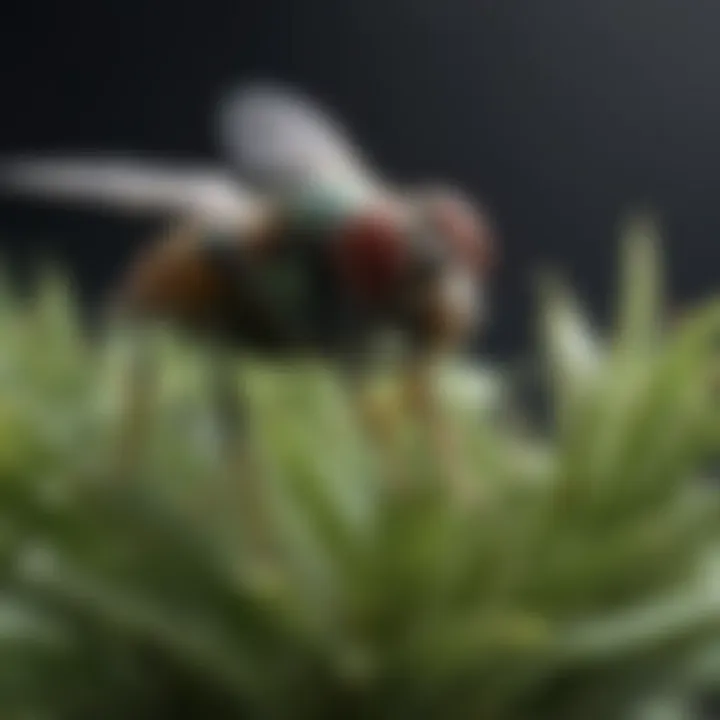
Intro
Plant flies, often a nuisance for gardeners and indoor plant enthusiasts, can severely impact plant health. Effective methods are necessary to manage these pests, ensuring that plants thrive in their environments. This article will explore various aspects of the problem, including identification, prevention, and treatment options. By understanding these elements, homeowners can create a more sustainable approach to pest management.
Identification of Plant Flies
Identifying plant flies is crucial for effective management. Common species include fungus gnats, whiteflies, and fruit flies. Each of these pests has distinct characteristics.
Fungus gnats are small, dark, and often found in the soil of potted plants. Their larvae feed on plant roots, leading to deterioration. Whiteflies appear as small, white insects found on the undersides of leaves. They can weaken plants by sucking sap. Fruit flies are generally attracted to overripe or decaying fruits and vegetables, making them common in kitchens.
Signs of Infestation
- Yellowing Leaves: Look for discoloration, a sign of stress due to pests.
- Sticky Residue: Whiteflies often leave a sticky substance known as honeydew.
- Visible Flies: Observing any small flies around plants signals a potential infestation.
Prevention Strategies
Preventing the arrival of plant flies is often more effective than dealing with an infestation. Here are some strategies:
- Proper Watering Practices: Overwatering creates a suitable environment for fungus gnats. Allow soil to dry between waterings.
- Sanitation: Keep the planting area clean. Remove dead leaves and debris that might attract pests.
- Choosing Healthy Plants: Inspect any new plants for signs of pests before introducing them to your space.
Treatment Options
When prevention fails, several treatment options are available. These range from chemical solutions to organic methods.
Chemical Solutions
- Insecticidal Soaps: Effective against soft-bodied insects like whiteflies.
- Neem Oil: This natural pesticide disrupts the life cycle of many plant pests.
Organic Methods
- Sticky Traps: Yellow sticky traps attract and capture adult flying insects.
- Diatomaceous Earth: Sprinkling this on the soil can deter and kill pests without harming plants.
Sustainable Practices
Emphasizing sustainable practices is important in pest management. These approaches not only protect plants but also ensure environmental health. This can be achieved through:
- Companion Planting: Certain plants repel pests while supporting the growth of others.
- Natural Predators: Introducing beneficial insects like ladybugs can keep pest populations in check.
"Preventative measures are always more effective than reactive solutions in pest management."
End
Prelims to Plant Flies
Understanding plant flies is crucial for anyone involved in gardening or interior plant care. These pests can severely impact plant health and aesthetics. Their presence often leads to weakening of plants, which can diminish the enjoyment of gardening. Being informed about plant flies allows homeowners and gardening enthusiasts to take preventative measures and act promptly when infestations occur. This article emphasizes the need for awareness concerning these pests, mainly focusing on identification, prevention, and treatment strategies that contribute to healthy plant growth.
Understanding Plant Flies
Plant flies refer to a variety of insects that affect plants. Commonly, these flies fall under the category of fungus gnats and fruit flies. Fungus gnats thrive in moist soil conditions and feed on organic matter. Fruit flies, on the other hand, are usually attracted to decaying fruits or vegetables. Recognizing their behavior and habitat preferences is necessary for effective management. Gardeners must learn about the life cycles and reproductive habits of these flies. Awareness helps in early detection, minimizing the risk of significant damage.
Common Species of Plant Flies
Several species of plant flies pose risks to gardeners. Here are a few notable ones:
- Fungus Gnats (Bradysia spp.): The larvae of fungus gnats feed on roots and organic matter in the soil. They are small and dark in color, often flying around damp, indoor plants.
- Fruit Flies (Drosophila melanogaster): These flies primarily target overripe or decaying fruits. They are light brown and are easily recognizable by their red eyes.
- Whiteflies (Trialeurodes vaporariorum): While not true flies, whiteflies resemble small moths. They tend to congregate on the undersides of leaves and suck sap from plants, causing stress.
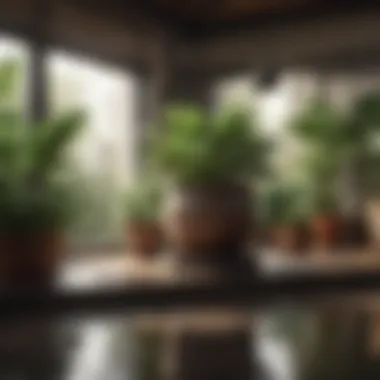

By understanding these common species, gardeners can make informed decisions about management strategies.
Identifying Plant Fly Infestations
Identifying plant fly infestations is crucial for effective management. Early detection allows for swift action, which can prevent severe damage to plants. Understanding how to recognize these infestations not only keeps plants healthy but also reduces the spread to other plants in your collection. This section covers the signs of infestation and how to thoroughly inspect your plants.
Signs of Infestation
Recognizing the signs of infestation is the first step in managing plant flies. These pests can be elusive, but certain indicators often reveal their presence:
- Visible Flies: Adult flies are often seen hovering near affected plants. They are small, typically less than a quarter-inch long, and may appear as dark specks.
- Damaged Foliage: Look for yellowing leaves or leaf drop. This can be a sign of feeding activity. Damage may also show as mottling or wilting.
- Stunted Growth: If plants seem to grow at a slower rate or show signs of decline, it may indicate a hidden infestation.
- Webbing or Mold: In some cases, the presence of webbing on plants or a sooty mold can indicate the existence of pests. This can be the result of secretions left by the flies or their larvae.
Identifying these signs quickly can save your plants from further harm, making it imperative to remain vigilant.
Inspecting Your Plants
A detailed inspection provides insight into the health of your plants and can confirm the presence of plant flies. Here’s how to conduct an effective examination:
- Visual Inspection: Start by looking closely at the leaves, especially the undersides where flies may lay their eggs. Use a magnifying glass if needed to spot small flies or larvae.
- Soil Examination: Check the top layer of soil. If you notice small larvae or eggs, this could mean an infestation is present.
- Sticky Traps: Implement sticky traps around your plants. These will catch adult flies and provide a clearer picture of the infestation level.
- Regular Checks: Make it a habit to inspect your plants weekly. Catching an infestation early is vital for effective treatment.
"Regular inspections are essential for maintaining healthy plants and preventing the spread of pests."
Conducting these thorough inspections will help ensure you detect plant flies before they become a bigger problem.
Preventive Measures
Preventive measures are essential for managing plant flies effectively. By understanding potential risks and implementing strategic practices, gardeners can significantly reduce the likelihood of infestations. Prevention saves time, money, and the stress associated with dealing with pests in the first place. Focusing on this segment of plant care enhances the health and resilience of plant life in both indoor and outdoor environments.
Cultural Practices to Avoid Infestation
Adopting the right cultural practices can create an environment less favorable for plant flies. One key element is maintaining plant hygiene. Regularly removing dead leaves and decaying organic matter reduces breeding grounds.
- Rotate Crops Regularly: Changing the location of your plants every season can disrupt the life cycle of pests that thrive in specific conditions.
- Proper Spacing: Ensure adequate spacing between plants. This allows for increased airflow, reducing humidity around the foliage where flies thrive.
- Thorough Soil Management: Use well-draining soil to avoid excess moisture, which attracts flies. Healthy soil is less likely to harbor infestations.
Cultural practices also involve studying and understanding local pest behavior. This might require observing when certain species are more prevalent and adjusting planting schedules accordingly.
Optimizing Your Watering Schedule
Water management is a crucial aspect of preventing plant flies. Overwatering creates an environment ripe for pests and diseases. Here are several considerations:
- Consistency in Watering: Establish a routine that maintains adequate moisture without oversaturation. Check soil moisture levels before watering.
- Time of Day for Watering: Watering early in the morning allows excess moisture to evaporate throughout the day, minimizing humidity levels overnight.
- Drainage: Ensure that pots and garden beds have adequate drainage systems. Silty or clay-heavy soils can retain water, attracting pests.
Focusing on a proper watering schedule not only aids in plant health but also minimizes conditions favorable for pest development.
Selecting Healthy Plant Varieties
Choosing resistant or hardy plant varieties is another effective preventive strategy. Some plants naturally deter pests or are less susceptible to infestations. Look for:
- Native Species: Native plants are more likely to thrive in local conditions and resist local pests.
- Hybrid Varieties: Certain hybrids are developed with pest resistance in mind. Research what works best in your climate.
- Healthy Plants from the Start: Always purchase plants from reputable sources. Inspect for any signs of damage or pests before bringing new plants home.
Incorporating healthy plant varieties into your garden can create a sustainable environment, making it more difficult for plant flies to establish themselves.
The best offense is a good defense. By adopting preventive measures, gardeners significantly lower the risk of plant fly infestations, creating a healthier environment for their plants.
Chemical Control Options
Chemical control options play a vital role in managing plant fly infestations, especially when natural methods prove insufficient. They offer several benefits, one of which is their ability to act quickly and effectively. Homeowners and gardening enthusiasts often feel overwhelmed once they notice a population of plant flies affecting their cherished plants. Understanding how to properly use chemical treatments can often lead to immediate improvements in plant health and overall garden conditions.
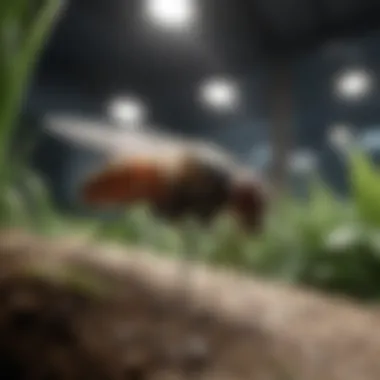
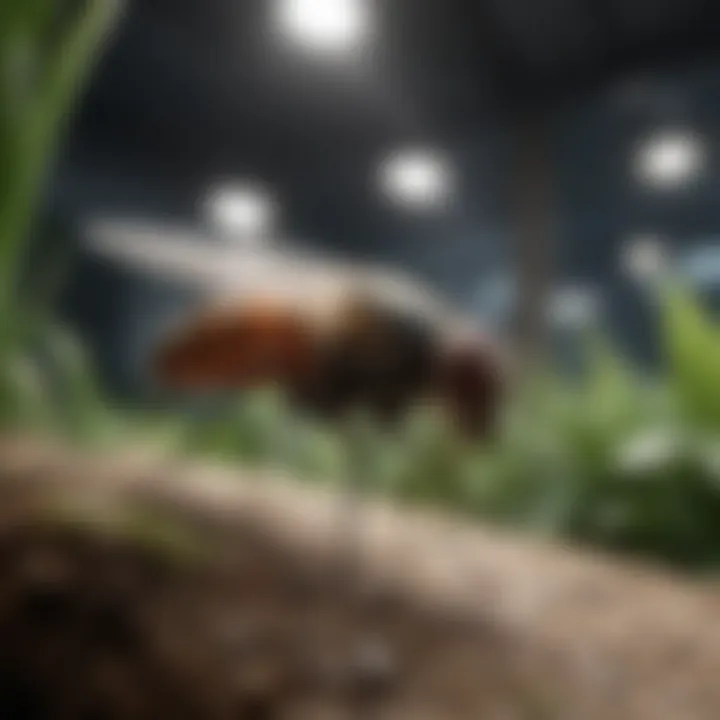
When considering chemical control options, it is important to assess the specific type of plant fly and the level of infestation. Different insecticides target various pests, so the right choice can make a significant difference. Moreover, understanding the formulation and application techniques will ensure better results and minimize risks to beneficial insects and the environment.
"Using chemicals responsibly and knowledgeably can greatly enhance the health of your plants while keeping pests at bay."
Insecticides: The Basics
Insecticides are chemical agents designed to kill or repel insects. They come in various forms, including sprays, granules, and concentrates. Each type has its own advantages and limitations, making them suitable for different gardening conditions. Some of the most commonly used insecticides for plant flies include:
- Pyrethroids: Synthetic chemicals that mimic natural insecticides found in chrysanthemum flowers. They are effective but might harm non-target insects.
- Neonicotinoids: Systemic insecticides that are absorbed by plants, providing long-lasting protection. Use these cautiously as they can affect bees and other pollinators.
- Insecticidal soaps: Effective against soft-bodied insects and break down quickly in the environment. They pose less risk to beneficial insects but require several applications.
When choosing an insecticide, it's crucial to read the product label carefully. This provides insights into the active ingredients, application rates, and safety precautions needed to protect yourself and the environment.
Application Techniques
Proper application of insecticides enhances their effectiveness and reduces potential side effects. Adhering to some key techniques can improve results when combating plant fly infestations.
- Timing: Apply insecticides during early morning or late evening when beneficial insects are less active. This increases the effectiveness on target pests and minimizes disruption in the ecosystem.
- Direct Application: Target the affected areas directly. For instance, spraying on stems and the undersides of leaves where plant flies often reside can yield better results.
- Follow Label Instructions: Each product comes with specific usage instructions. Following these guidelines ensures proper dosage and method of application, optimizing the treatment while keeping the environment safe.
- Safety Gear: Always wear protective clothing, gloves, and a mask when applying insecticides to avoid exposure.
Understanding these techniques is valuable for achieving better control over plant flies. When used correctly, chemical control options can significantly aid in maintaining a healthy garden, making them an indispensable part of an integrated pest management strategy.
Organic Treatment Methods
Organic treatment methods are crucial in the battle against plant flies. They offer effective solutions while minimizing harm to the environment and beneficial organisms. More gardeners are moving toward these methods as a response to stringent regulations surrounding chemical pesticides, along with rising awareness about sustainability.
One significant advantage of organic treatments is their ability to effectively target pests without leading to chemical residues on plants. Additionally, they promote a healthier ecosystem, which is vital for long-term plant health. Unlike synthetic pesticides, organic options often enhance soil health and encourage natural pest control methods.
However, it is essential to consider that organic treatments may require a different approach to application compared to chemical options. The effectiveness might not be immediate, demanding persistence and consistency in usage. Understanding the specific needs of your plants and timing for application can significantly improve the outcomes.
Natural Insecticidal Solutions
Natural insecticidal solutions can be a powerful ally in combating plant flies. Ingredients such as neem oil, diatomaceous earth, and insecticidal soap are popular choices. Neem oil disrupts the life cycle of insects, preventing them from maturing into adults. Diatomaceous earth, made from fossilized algae, acts as a desiccant. It causes physical damage to the insects, leading to dehydration, which is an effective way to manage infestations without harming the plants.
Insecticidal soap works by suffocating insect pests, making it an effective option against soft-bodied insects like plant flies. When applying these solutions, it is critical to follow the instructions and test on a small area before treating the entire plant.
Companion Planting: A Preventative Strategy
Companion planting serves as a preventative strategy against plant flies and other pests. This technique involves growing certain plants together to naturally repel pests and enhance growth. For example, marigolds are known to deter a range of insects, including plant flies, making them an excellent companion for vulnerable plants.
Additional combinations, such as basil near tomatoes, can not only enhance flavor but also protect against pests. This method fosters a biodiverse environment, improving ecological balance.
Overall, organic treatment methods are not just about removal but also about creating a more sustainable garden environment. They promote a holistic approach to pest management that aligns with sustainable gardening practices.
Homemade Solutions
Homemade solutions play a crucial role in managing plant flies effectively. These approaches are often favored for their accessibility and low cost. Homeowners can use common household items to create their own pest control measures. This not only saves money but also reduces the reliance on chemical products which may not be environmentally friendly. Those who prefer sustainable gardening practices will find homemade solutions particularly appealing.
One of the major benefits of homemade solutions is their safety. Many recipes involve non-toxic ingredients, making them suitable for use around pets and children. This is a significant consideration for households that prioritize safety in their living spaces. Moreover, without harsh chemicals involved, these methods can often be gentler on plants, minimizing the chance of damage to leaf structures and overall health.
Incorporating homemade solutions in pest control strategies requires some knowledge about the materials and ingredients. For this reason, DIY traps and effective home remedies will be discussed in the following sections to provide actionable insights for dealing with plant flies.
DIY Traps for Plant Flies
DIY traps are an excellent way to manage plant fly populations. They can be constructed using simple materials that are often readily available at home. The most basic traps include vinegar, soap, or fruits. For example, a simple apple cider vinegar trap can attract adult flies.
To create an apple cider vinegar trap, follow these straightforward steps:
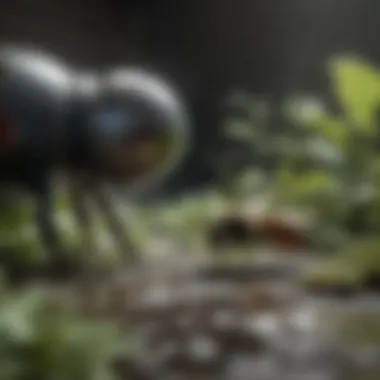
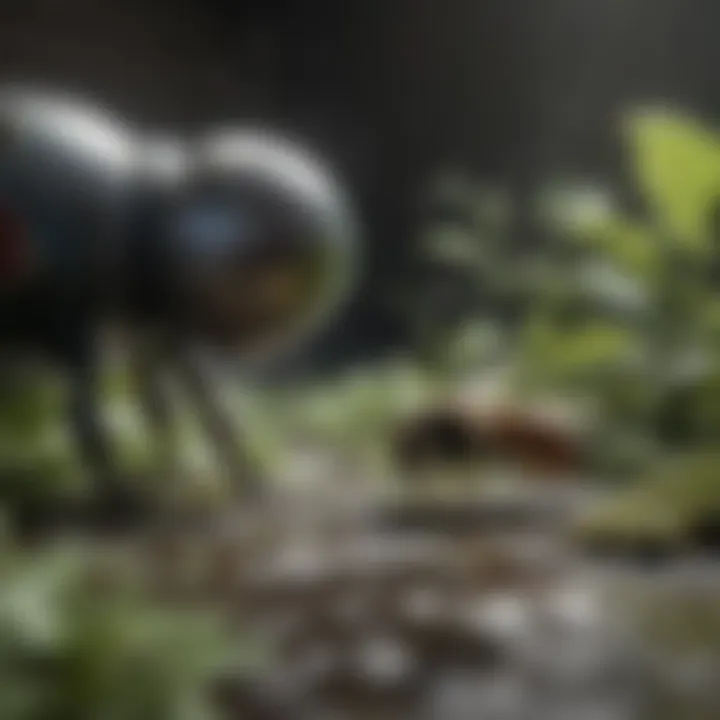
- Gather materials: You will need a jar, apple cider vinegar, dish soap, and a piece of plastic wrap.
- Prepare the jar: Pour about an inch of apple cider vinegar into the jar. The strong scent will lure the flies in.
- Add dish soap: Mix a few drops of dish soap into the vinegar. This breaks the surface tension, preventing flies from escaping once they land.
- Seal the jar: Cover the top with plastic wrap, then poke small holes. Flies will enter through these holes but struggle to escape.
- Position the trap: Place the trap near infested plants for maximum effectiveness.
By using this method, homeowners can expect to see a significant reduction in adult plant flies around their living space. Setting up multiple traps around the house can yield better results.
Effective Home Remedies
In addition to making traps, there are various effective home remedies for controlling plant flies. These remedies integrate natural ingredients that help deter or kill flies on contact. Two common remedies include using neem oil and diatomaceous earth.
Neem oil is derived from the seeds of the neem tree. It has insecticidal properties effective against a variety of pests. To use neem oil:
- Mix two teaspoons of neem oil with a quart of water and a few drops of dish soap.
- Spray this mixture on infested areas, making sure to coat both the upper and lower surfaces of the leaves. Repeat every week until the problem subsides.
Diatomaceous earth is another effective solution. It works by dehydrating insects that come into contact with it. To apply diatomaceous earth:
- Lightly sprinkle it in areas where infestations are found.
- Make sure to reapply after watering or rain, as it loses effectiveness when wet.
Overall, embracing homemade solutions allows for more sustainable plant care. Whether by setting traps or applying natural remedies, these methods offer considerable options for homeowners confronting plant flies.
Monitoring and Maintenance
Monitoring and maintenance are vital components in the management of plant flies. These practices ensure that potential infestations are detected early, allowing for timely intervention. This proactive approach is crucial not just for the immediate well-being of your plants, but also for long-term garden health. By incorporating regular observations and sustaining clean environments, you significantly increase the chances of preventing plant fly infestations.
Regular Plant Inspections
Regular plant inspections help you become familiar with the typical appearance and behavior of your plants. This familiarity is essential since it allows you to spot any changes that may indicate a problem. Aspects to inspect include:
- Foliage: Look for browning edges, spots, or other irregularities on leaves that can signal stress or pest issues.
- Stems and Roots: Inspecting stems for damage or swelling can provide clues about underlying problems. Roots can be checked by pulling out pots carefully to observe their condition.
- Presence of Flies: Adult plant flies can often be seen hovering near infested plants, making it critical to monitor for any unusual activity.
These inspections should ideally occur weekly, allowing for timely responses to any identified issues. By doing so, you can identify problems before they escalate into a full-blown infestation.
Proper Hygiene Practices
Maintaining proper hygiene is essential for keeping plant flies at bay. Good hygiene practices reduce the chances of attracting pests and helps keep your plants healthy. Here are key hygiene strategies to adopt:
- Cleaning Tools: Always sanitize tools after use. Tools can harbor pests and diseases that easily transfer from one plant to another.
- Removing Debris: Clear away dead leaves and plant debris regularly. Such material can serve as breeding grounds for plant flies.
- Water Management: Overwatering can create damp environments, making your plants susceptible to infestations. Ensure pots have adequate drainage and avoid leaving standing water.
"Maintaining a clean environment is not just about aesthetics; it is essential for protecting plant health."
Every action you take to maintain cleanliness contributes to the overall resilience of your plants against pest invasions. By implementing a vigorous monitoring and maintenance routine, you create a less hospitable environment for plant flies, promoting a thriving garden.
By mastering these practices, you lay a solid foundation for effective management of plant flies, ensuring your plants remain healthy and vibrant.
Culmination
The conclusion of this article emphasizes the significance of adopting a comprehensive approach to eliminate plant flies. Addressing these pests is essential for maintaining the health and beauty of your plants. When plant flies infest, they can damage foliage, impede growth, and introduce diseases. Thus, understanding various strategies available to mitigate their presence becomes imperative.
Recapping Effective Strategies
To effectively manage plant flies, consider the following strategies:
- Identification: Understanding the species involved is crucial. Regular inspections can reveal early stages of infestations before they escalate.
- Preventive Measures: Implement cultural practices, such as optimizing watering schedules and selecting resilient plant varieties. This limits the chances of fly infestations.
- Chemical Controls: When necessary, utilize insecticides. Understanding their application techniques can improve effectiveness.
- Organic Solutions: Embrace natural insecticidal solutions alongside companion planting to create an environment less hospitable for flies.
- Homemade Solutions: Craft DIY traps and explore effective home remedies to combat the problem.
- Monitoring and Maintenance: Regular inspections combined with proper hygiene practices will support ongoing fly management.
Ultimately, a fundamental understanding of these methods allows for informed decisions to combat plant flies effectively.
Encouraging Sustainable Gardening Practices
Sustainable gardening practices are vital for both environmental health and effective pest management. Approaches such as:
- Diversity: Encourage biodiversity in your garden. This not only attracts beneficial insects but also reduces pests.
- Natural Solutions: Utilize organic methods whenever possible. Not only do these solutions protect your plants from flies, but they also safeguard beneficial microorganisms in the soil.
- Education: Stay informed about sustainable practices. Knowledge is a powerful tool in gardening, enabling homeowners to adapt and respond to challenges efficiently.
Encouraging practices that align with sustainability leads to a healthier ecosystem, fostering long-term plant health and minimizing invasive pest problems.
Overall, addressing plant fly infestations with a combination of effective strategies and sustainable practices will greatly enhance your gardening success and the vitality of your plants.







